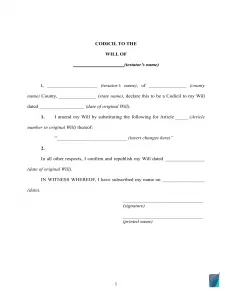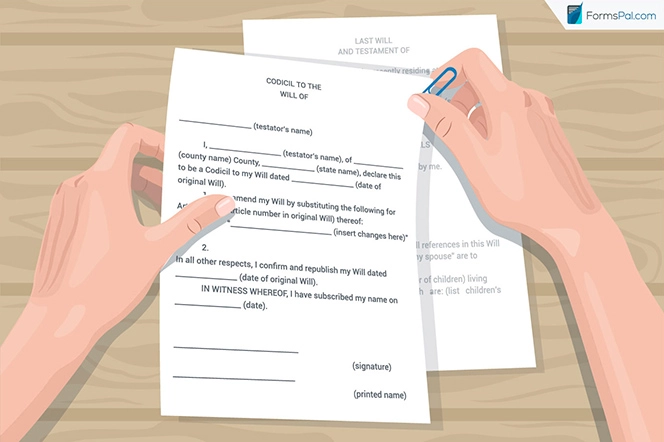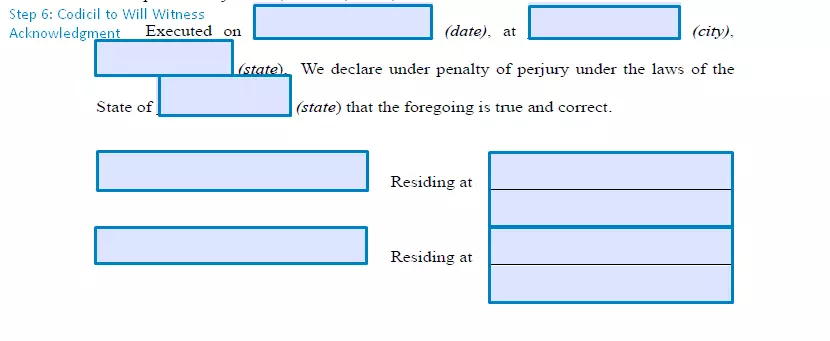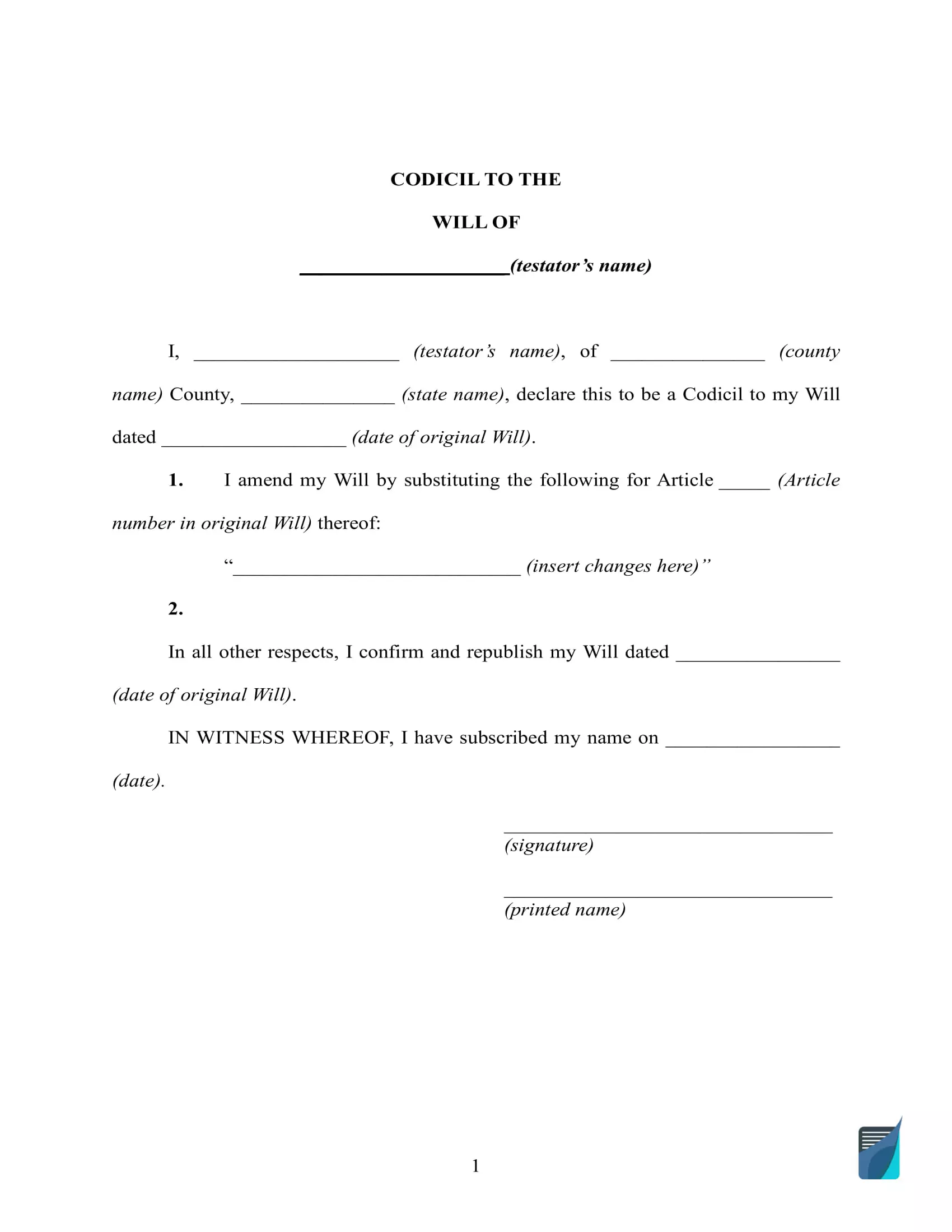Free Codicil to Will Form
A codicil to will form is a legal document that allows you to make edits and changes to the content of an existing will without having to completely rewrite and replace the original document. They are an incredibly useful tool for streamlining changes, and knowing that you can alter your will with a codicil makes it easier to keep your will as close to your wishes as possible.
Here’s a good working codicil definition:
An addition or supplement to your will that explains, modifies, or revokes a will or its part.
However, just like creating a last will and testament form, or a living will, you do have to follow a specific procedure to create a codicil and attach it to your will. This article will cover when a codicil is useful, how to create one, and when you might be better served by creating a new will instead.
Codicil to Will Form Details
| Document Name | Codicil to Will Form |
| Other Names | Codicil to Last Will and Testament, Addendum to a Will |
| When to Use | Change of the will executor, Inclusion of new beneficiaries, Marriage or other relationship changes, New assets, etc. |
| Notarization | Only Louisiana requires wills and codicils to be notarized |
| Avg. Time to Fill Out | 5-60 minutes, depending on the changes made |
| # of Fillable Fields | 29 |
| Available Formats | Adobe PDF, Microsoft Word |
When Do I Need to Use a Codicil?
A codicil is recommended whenever you need to make a relatively small change to your existing will, but that change doesn’t substantially re-write the original document. A codicil is best for minor changes and when you only want to make one or two changes at a time.
For instance, here are two codicil cases: you need to add a new property to your will or want to include a grandchild who wasn’t around when you wrote the original will. A codicil to will works well in those scenarios.
Codicils are typically used for:
- Including new beneficiaries
- Changing the executor of your will
- Adding new properties and assets to your will
- Minor changes to beneficiary inheritance (slightly rarer)
- Marriage or other relationship changes
- Other incidental changes
If you need another codicil example or aren’t sure if your situation works for a codicil, consult with your lawyer.
These are all good scenarios for codicils because it’s relatively straightforward to make those amendments. Usually, these are also scenarios that your beneficiaries are unlikely to dispute, so adding them in later is less likely to cause problems when it’s time to execute your will.
However, if you’re making more substantial changes, completely re-working your beneficiary structure, or removing a beneficiary entirely, it’s often better to write a new will.
That’s partly because the cost of the codicil for those more complicated alterations is likely to be just as high as the cost of a new will. A new will with a new date and completely fresh information is also less likely to be disputed than a complicated codicil with the original version of the will available.
Codicils don’t mean that the previous version of the will receives attorney-client privilege, but rewriting your will does.
Get a Free Codicil to Will Template

How to Add a Codicil
Writing a codicil doesn’t have to be difficult, but it’s critical that you do it correctly. We’ll outline what the process looks like, but state law varies and may need a different codicil template.
Your lawyer will know the state requirements, or you can download a state-specific blank codicil to will template here. Blank will codicil forms are usually pretty easy to fill out and can be a great starting point.
If you already have a legal representative that you can consult, they can also tell you how to write a codicil to a will.
Alternatively, we also offer a free codicil form that you can use to create a printable codicil to will. That way, you can make edits and changes digitally and then quickly print them before signing with witnesses. Our form also makes it easier even when you are working with a lawyer since you’ll start with a clearer understanding of what you want to change by writing those changes yourself and then working on the legal phrasing.
1. Find a Current Copy of Your Will and Decide on Changes

The first step should always be reviewing your existing last will and testament in case you want to make more than one adjustment to the document. Look over every provision before you start making a codicil since the more changes you make, the more likely your lawyer will recommend writing a new will instead.
2. Write the Codicil

All codicils have the testator’s name (the author of the will and listed assets) and address, the date the will was created, and the declaration, or changes being made to the will.
You’ll probably want to consult with a legal professional during this process, especially if you’re wanting to make more than one or two changes. A law firm might advise you on the best language to use and will help you decide whether this is a change for a codicil or a sign that you need a new last will and testament.
3. Sign the Codicil With Witnesses

Like a will, one requirement is that codicils be signed with at least two witnesses present. The witnesses have to watch the testator sign and cannot be beneficiaries named in the will. The witnesses also need to authorize the codicil after it is signed.
Optionally, you can also choose to get a self-proving affidavit, which requires your witnesses to swear under oath that they witnessed the testator sign the codicil. Self-proving affidavits also require the presence of a notary public to be considered valid.
4. Attach the Codicil to the Will

The last step is to attach the signed and witnessed codicil to your will and distribute copies of both documents to relevant individuals, often family members. Attaching the codicil is the last step of adding a codicil to a will.
You should also make sure that your lawyer has an up-to-date copy of both the will and codicil for safekeeping.
How to Fill Out a Codicil Form
If you want to fill out a codicil template that we provide on our website, here are brief instructions that will let you fill out the document in no time and without any complications!
Step 1: Information about the testator
1: Indicate the testator’s name two times: right under the document’s name and further at the beginning of the first paragraph.
2: Specify the testator’s county of residence.
3: Write down the state where the testator lives.

Step 2: Date of the original will
Further, indicate when the original will document was created.

Step 3: The article that is to be amended
Now, specify the essence of the amendment: what you want to change in your last will.
1: Mention the article (paragraph or part) in your original will that is going to be changed.
2: Write down how exactly you want it to be changed.

Step 4: Confirmation
The following language in the document will indicate that you, as the testator, confirm and republish your will. Insert the date of the original will once again.

Step 5: Date and signature
The next thing you should do is:
1: Place your signature
2: Indicate your printed name
3: Insert the date of signing

Step 6: Witness Acknowledgement
Lastly, the required number of witnesses should fill out each respective section. This section is meant to serve as proof that you are of sound mind, over 18 years old, and willingly created the codicil to your will.
It should include the name of the testator, date of the codicil creation, number of pages along with the place of the codicil execution, names, signatures, and places of residence of the witnesses.

When Should I Create a New Will?
There isn’t a hard and fast rule for when you should opt for a new will instead of a codicil. Depending on your lawyer, you may be recommended to write a new will if the changes you’re requesting would take just as much of your lawyer’s time as a new will since a new will is usually the more secure version of the two.
Case 1
Changing your beneficiary structure or moving some assets from one beneficiary to another can also be a good reason to create a new will. That’s because the new will only shows when it was created but doesn’t show any changes you made to the beneficiary structure.
A codicil lets everyone involved see both the original will and update, which can cause disputes and strife among your beneficiaries.
Case 2
It’s also a good idea to write a new will if you already have one codicil, or several, and need to update your will again. That’s because rewriting reduces the chances of having conflicting changes or disputable areas that can cause problems for your beneficiaries.
Case 3
The last thing you’ll want to consider when deciding between a codicil and rewriting your will is how controversial you think any given provision of your will might be.
A complete will is more durable than a poorly written codicil. So, if you’re worried that your beneficiaries might fight over certain provisions of your will or that your executor might have problems following sections of it, you’ll want to avoid putting those provisions in a codicil.
It’s worth noting that some lawyers tend more towards a codicil or more toward a will rewrite. Those preferences are typically only loosely connected to the cost of the document (and your lawyer will usually prefer the cheaper option). More important is your lawyer’s experience and which they think is more likely to be an effective and conflict-free option for the change you’re making.
Frequently Asked Questions
Can I revoke my codicil?
Yes. You can revoke or make changes to your codicil at any time, just like you can update your will whenever necessary. It’s a good idea to stay up to date on your current will and any attached codicils to make sure that it’s still relevant to your situation and accurate for how you want your estate to be handled.
Can a codicil be handwritten?
Technically, yes. A holographic will or codicil can be handwritten on your copy of your will, and depending on many different circumstances, may be considered valid.
However, it’s not recommended to hand-write codicils and other changes, partially because handwritten versions of those documents are almost never crafted with the advice of a lawyer. Minor differences in language that wouldn’t matter in another document can lead to disaster in legal papers, including your last will and testament.
It’s always best to seek a lawyer’s assistance with your will and any codicils, which will usually mean using a typed and properly witnessed document instead of a handwritten holographic will.
When is a codicil valid?
A codicil is valid as long as it’s been properly signed and witnessed, attached to your will, and has not been revoked by the testator or invalidated by another document.
How much would a codicil cost me?
Codicils vary in cost depending on how much you need to change in your will. Most codicils that make a minor change or adjustment are relatively inexpensive at around $100. However, the more changes you need to make or the more complicated your will already is, the more you should expect to pay.
At the same time, if your codicil is simple and you can fill out a blank codicil form, it will probably cost less.
Past a certain point, your lawyer may recommend changing to writing a new will because that may be the cheaper and more efficient option.

